We occasionally link to goods offered by vendors to help the reader find relevant products. Some of these may be affiliate based, meaning we earn small commissions (at no additional cost to you) if items are purchased. Here is more about what we do.
My sister has always been the miso enthusiast of the family.

Not that she ate it at every meal or used it as a replacement for leave-in conditioner or anything, but man, could she conquer a cloudy, salty bowl of miso soup at a restaurant.
I was always partial to something more bright and crunchy – like ice-cold greens with chunky carrot and ginger dressing – as my pregame-of-choice for whatever Asian delight was coming my way. However, each time a steaming bowl of broth was slid under my sister’s nose, I couldn’t help but feel at least a little curious.
Being the elder and more mature sibling that she is, I was always granted a bite, and those savory mouthfuls still stand out in my food memory bank.
That first spoonful of soup had a flavor unlike any I had ever experienced before. It was pungent and salty, and the delicate white cubes of tofu that cheerfully bobbed to the surface melted on my tongue.
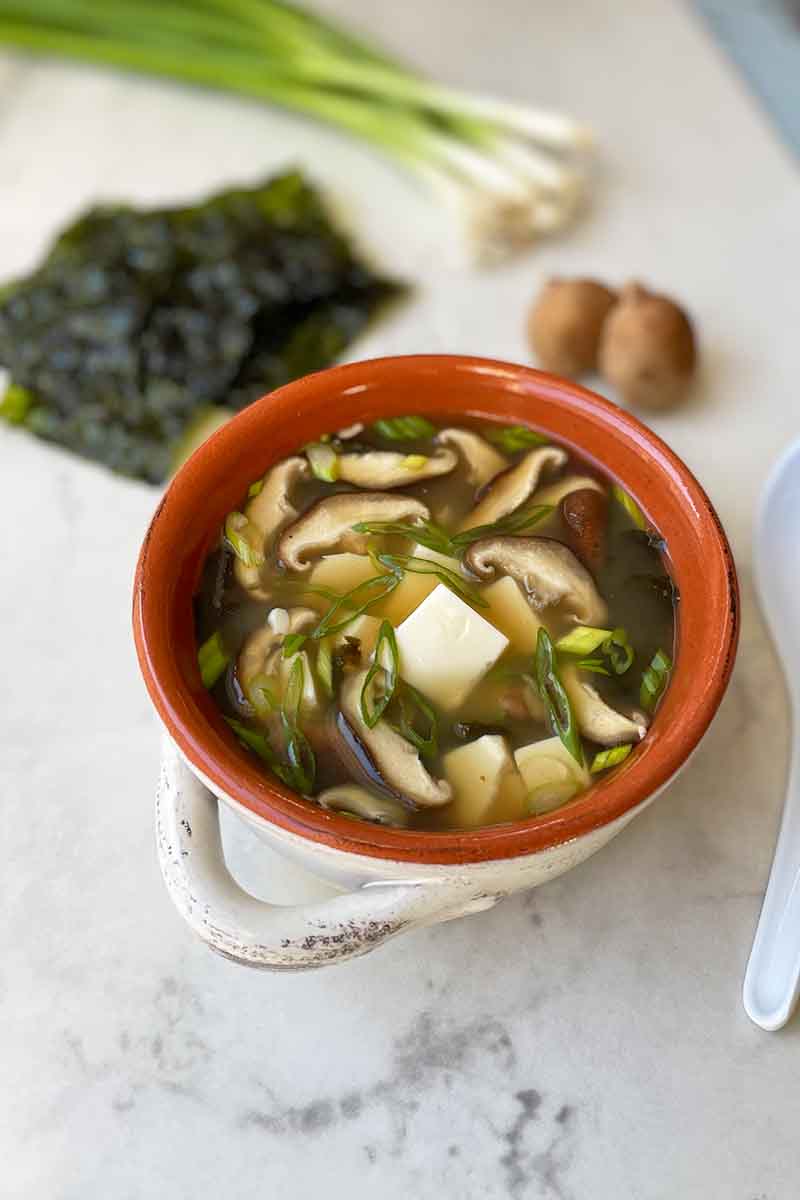
If we’re talking about the flavor of this soup (which obviously lends itself to a conversation about miso paste itself), I can’t go one sentence further without name-dropping one of my very favorite flavor descriptors:
Umami.
Not only is it wildly fun to say, it’s a little word with so much meaning. In addition to the usual subjects of culinary land that may touch down on your taste buds (salty, sweet, bitter, and sour), there is umami – synonymous with savory in the Japanese language.
Umami’s flavor compounds are often found in high-protein foods, which make your saliva glands go wild. Hence, this is why I drool when I see queso.
Miso paste is made of fermented soy beans. And while I would love to drone on about the ingredient, far more in-depth knowledge on the subject was already eloquently dropped in this article if you’d like to read more.

The smooth, pasty product is a bold condiment, and once you discover a few ways to weave it into your cooking, I guarantee you’ll be hooked.
Start slowly with the white variety 0f the paste. Its sweeter, more subtle flavor offers a gentle gateway into the world of umami, whereas you may not want to overwhelm your own or your dinner guests’ senses with darker varieties like red to start.
The red type is more funky and I find it is not everyone’s cup of tea. Or soup ingredient, in our case.
Wakame is the type of seaweed you’ll often see in miso soup, but nori sheets are a great substitute that’s often easier to locate at the grocery store.
Nori comes in flat, dried sheets, and wakame is satiny and looks a little shriveled. It also gets rehydrated before being added to soup, while nori dives straight in for a swim.
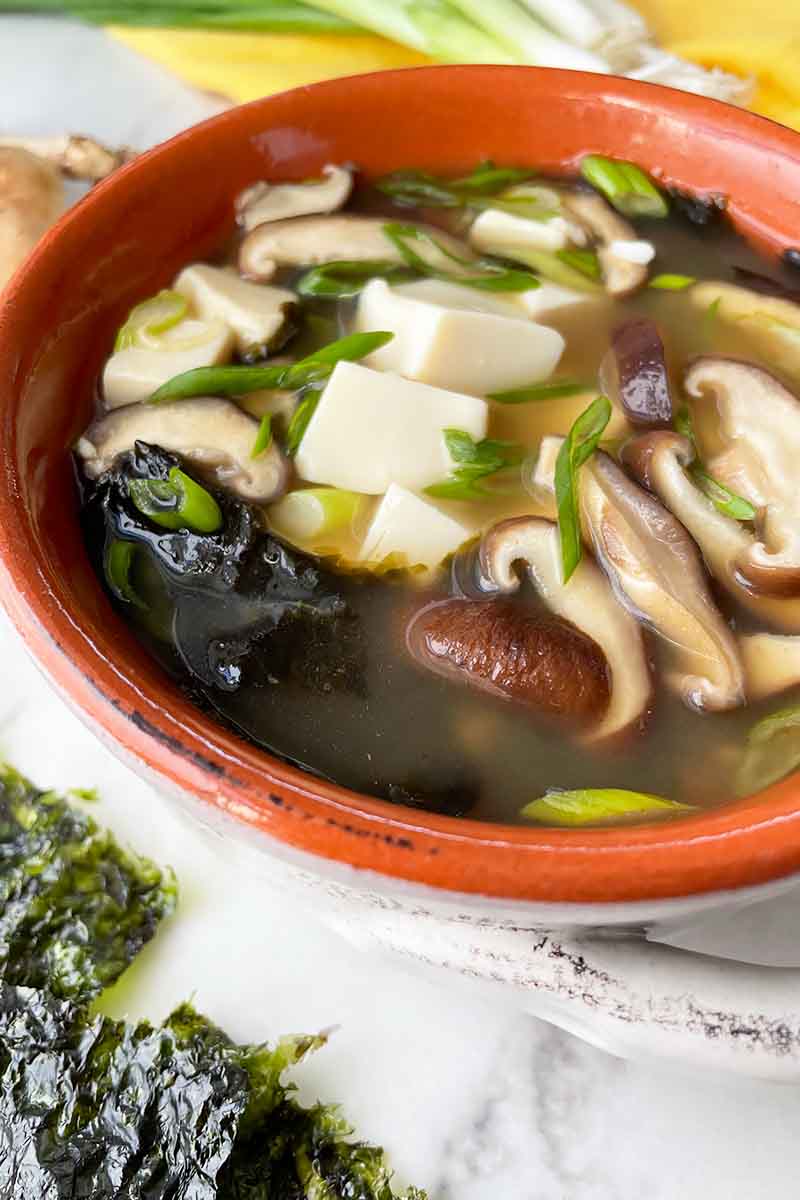
Mushrooms aren’t a must in this soup, but I find the meaty morsels enhance the soup’s savory flavors that much more – particularly shiitakes, which are already packing their own umami.
I will confidently state that the pop of chopped sweet green onions is indispensable, and adds all-important texture to a dish mainly made up of more readily slurp-able ingredients.
Now that I’ve mastered this quick, flavor-packed broth (which comes to fruition in under thirty minutes, mind you), I no longer have to beg my sister for a briny bite.
So grab yourself a spoon, but make your own batch.
Print
Easy Miso Soup
- Total Time: 25 minutes
- Yield: 4 servings 1x
Description
Delicate tofu, tender shiitakes, and green onions grace the broth of this simple miso soup that comes together in under thirty minutes.
Ingredients
- 6 cups low-sodium vegetable stock
- 1 8-ounce package silken tofu, cut into 1-inch cubes
- 1/2 cup shiitake mushrooms, stemmed and sliced
- 1 sheet nori (dried seaweed), chopped into large pieces (about 1/2 cup)
- 4 tablespoons white miso paste
- 4 medium green onions, chopped (about 1/2 cup)
Instructions
- In a large saucepot over high heat, bring the vegetable stock to a boil. Lower the heat to medium-low and add the tofu, mushrooms, and seaweed.
- Simmer, stirring occasionally, until the mushrooms have softened, about 5 minutes.
- Meanwhile, place the miso in a small bowl and whisk in about 2 tablespoons of the hot stock until smooth, to ensure that it doesn’t add lumps to the soup.
- Stir the miso mixture into the soup until fully incorporated. Add the green onions and simmer for 3 more minutes. Season to taste with additional miso paste or a pinch of salt, if desired.
- Divide the soup among bowls and serve hot.
- Prep Time: 15 minutes
- Cook Time: 10 minutes
- Category: Soup
- Method: Stovetop
- Cuisine: Vegetarian
Keywords: miso, soup
Cooking By the Numbers…
Step 1 – Prep Soup Ingredients
Drain the tofu and cut it into 1-inch cubes. I prefer to use silken tofu as it has a smooth texture and melts right into the broth. Because it’s delicate, be sure to stir it in gently.
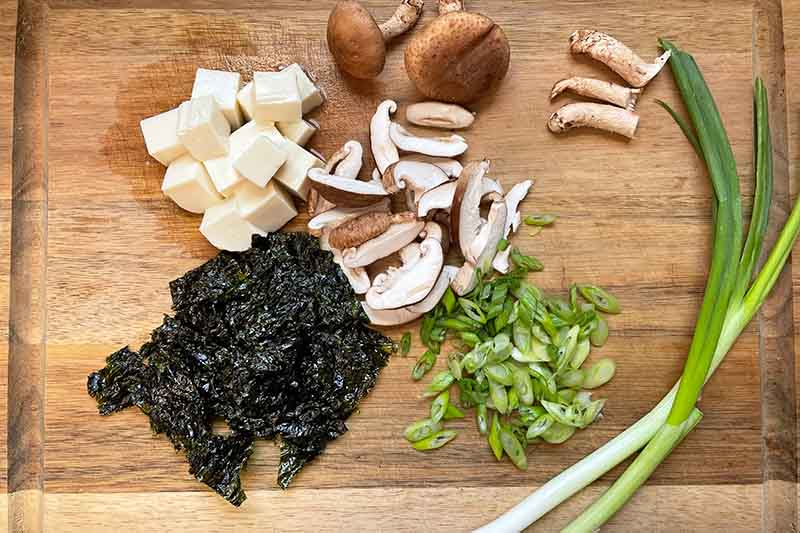
Stem and thinly slice the shiitake mushrooms.
As alternatives, you could use oyster or enoki mushrooms – though you should make sure to add enokis in during the last several minutes of cooking (along with the green onions) rather than at the start, because they’re thinner and flimsier than the other varieties.
Chop the nori and green onions.
Step 2 – Boil the Stock and Build the Soup
In a large saucepot over high heat, bring the vegetable stock to a boil. Lower the heat to medium-low and add the tofu, mushrooms, and seaweed.
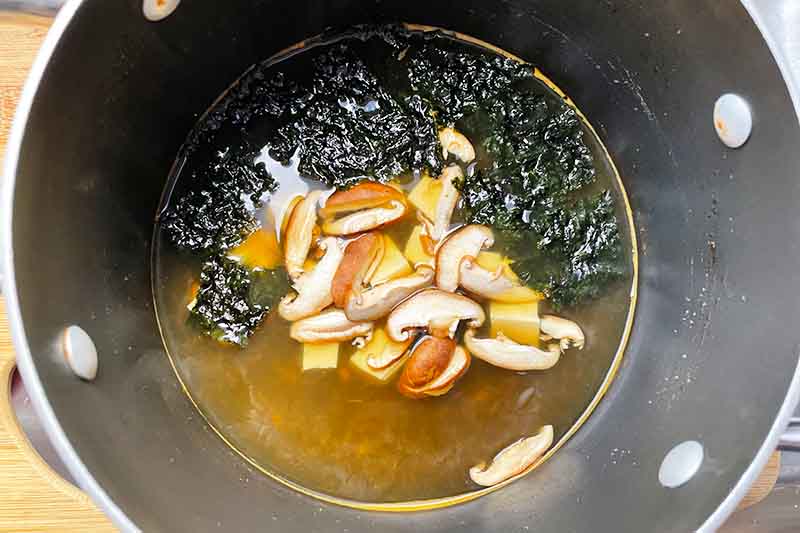
Simmer, stirring occasionally, until the mushrooms have softened. This will take about 5 minutes.
Step 3 – Prep and Add the Paste
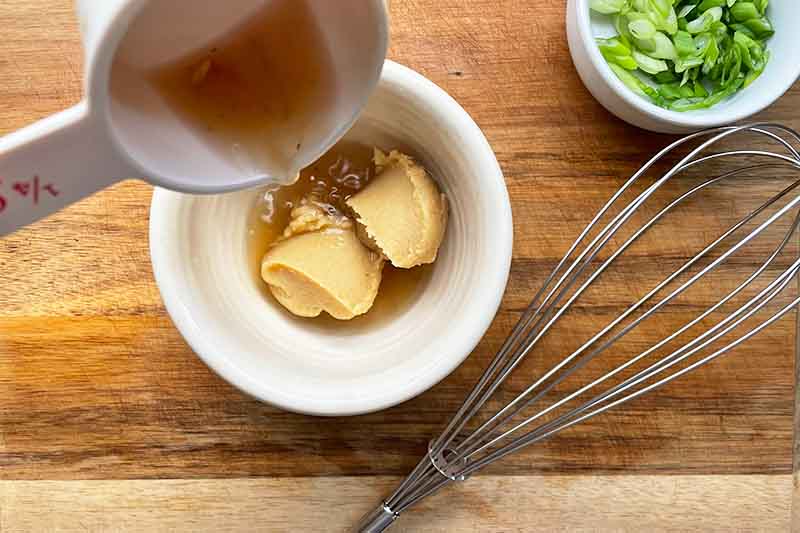
White miso (also called sweet or mellow) has the mildest flavor because it’s fermented for the least amount of time, but you can use any color you like.
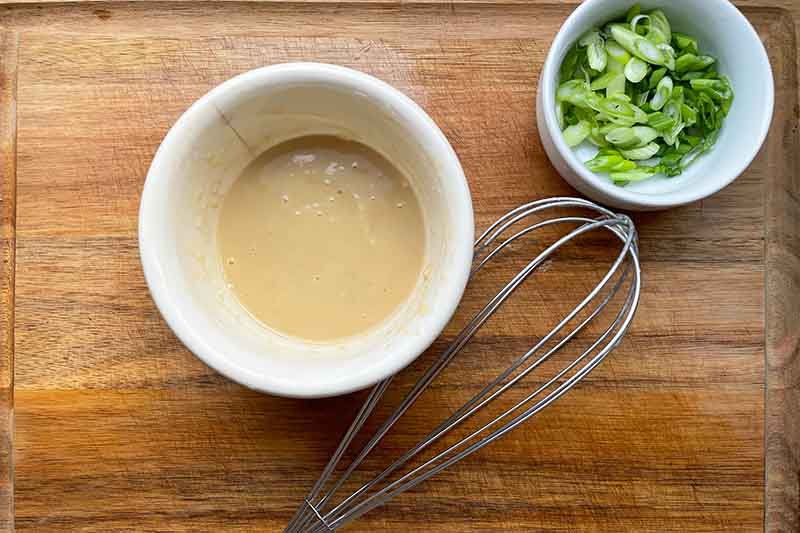
You want to make sure the paste is free of lumps before it goes into the pot, so you’ll make a slurry first. To do this, place the paste in a small bowl and whisk in about 2 tablespoons of the hot stock until it’s smooth.

Stir this mixture into the soup until it’s fully incorporated, and then add the green onions.
Step 4 – Simmer and Serve
Simmer for 3 more minutes.
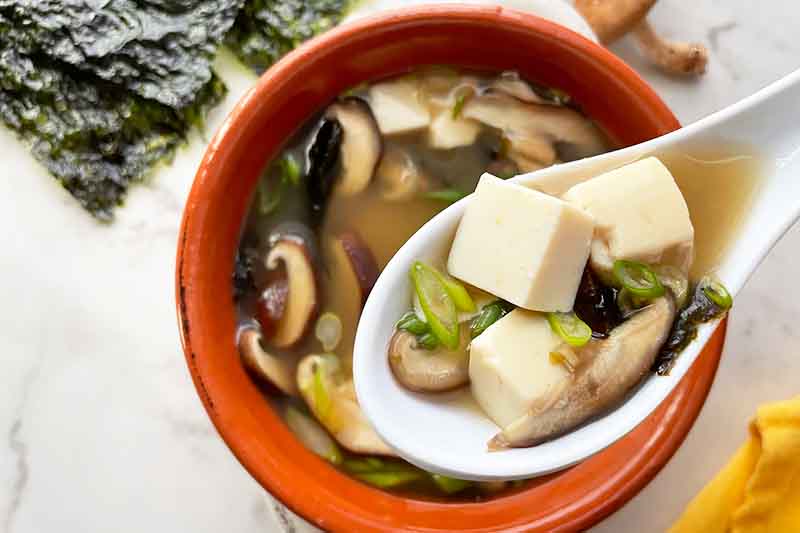
Season to taste with additional paste or a pinch of salt, if desired. You can also season the soup with soy sauce or tamari, which is darker, gluten-free, and less salty, with a stronger, more savory flavor than regular soy.
Divide the soup among bowls and serve hot.
All Hail Mighty Miso
Although a dab more miso added at the end can fine-tune the seasoning to your liking, it’s not the only road to Flavortown. I tap in a few drops of a spicy sesame oil like this one from Eden Foods for some heat. It’s available on Amazon.

Dashi is the standard broth used in this style of soup, but our quick version calls for vegetable stock instead. If you eat fish, feel free to grab some dashi powder to boost the umami and go the more traditional route. You can find it on Amazon as well.
I think a homemade stock (even just a simple veg version) is the key to really stellar soup, so don’t shy away from making one in advance and keeping it in the freezer for miso emergencies. Sometimes I sneak soba noodles into my soup for extra bulk, too.
Will you make yours into a meal, or leave it as is to serve as a light first course? Share your soup suggestions in the comments below! And don’t forget to give this recipe a five-star rating if you loved it.
Hungry for more dishes that showcase miso paste? You’ll love these recipes:
- Roasted Butternut Squash & Black Bean Rice with Hemp Miso Dressing
- Buttered Miso Roasted Potatoes
- Roasted Sweet Potato, Corn, and Black Bean Salad with Spicy Dressing
Photos by Fanny Slater, © Ask the Experts, LLC. ALL RIGHTS RESERVED. See our TOS for more details. Originally published by Jennifer Swartvagher on May 26, 2015. Last updated on January 3, 2022.
Nutritional information derived from a database of known generic and branded foods and ingredients and was not compiled by a registered dietitian or submitted for lab testing. It should be viewed as an approximation.
About Fanny Slater
Fanny Slater is a home-taught food enthusiast based in Wilmington, North Carolina who won the “Rachael Ray Show” Great American Cookbook Competition in 2014, and published her cookbook “Orange, Lavender & Figs” in 2016. Fanny is a food and beverage writer, recipe developer, and social media influencer. She was a co-host on the Food Network series “Kitchen Sink,” was featured on Cooking Channel’s longtime popular series “The Best Thing I Ever Ate,” and continues to appear regularly on the “Rachael Ray Show.”





That is a very simple miso soup recipe, but it looks and sounds great. Miso is my preferred soup whenever we go out for Chinese or anything Asian. Wonton soup is pretty good, too, though. I haven’t had Miso in a few weeks, I’d say if I had to take a guess. Thanks for the great recipe!
Miso has been a savior to me when traveling as it’s vegan I can always have it. I know some may use fish stock but many don’t because so many vegans and vegetarians use it as a base for noodles or dumplings. With some udon noodles and a few dumplings it a meal for me. I also like to have it when I am under the weather as it is soothing and healing, my version of chicken soup.
Despite loving Asian food, I have never tried miso soup. I don’t have these ingredients on hand, but I do think I can get them locally, and if not, it’s good to know that I can order them through Amazon. Thanks for the recipe, and the links. I’m sure many aren’t able to find some of these ingredients where they are. I might actually try it with the tofu, since I occasionally enjoy that, too.
I have never eaten miso before, or a liquid soup like depicted in the picture. I like all the ingredients though and think they will make a nice flavor. It is good to have a recipe showing how to use the miso and I look forward to trying it out. I have read that it is healthy and tasty, so that is what I love in my diet. I also know the silken tofu will absorb all those flavors and be like a delicacy.
I didn’t realize how easy miso is! I figured it took a lot of work and have always just ordered it when out. I will certainly give this a try at home on my next Asian dinner night. I have never noticed the paste or wakame at my normal supermarket, however there is a Chinese grocery just down the street I never really had an excuse to check out. Excuse found!
I once had a spicy miso when I was traveling, I wonder what the proper ingredient would be to use to make that?
I’ve only ever come across miso soup in dehydrated packets, ready for boiling water to be added. a from-fresh recipe seems much more appealing and authentic. Like jonyMacdonald above, I’d be interested in trying a spicier version too so was wondering wnat the best thing to add to give it a bit of a kick would be?
Miso soup is a comfort food for many people where I live. It’s one of the few things that doesn’t trigger my soy sensitivity, because the soybeans are fermented. But since most restaurants use tofu, I either have to forgo it, or pick out the tofu and give it to someone else, haha. When it’s been homemade I’ve only ever had it out of the dehydrated packets, never made miso soup out of the paste. I’ll definitely have to try it out, perhaps with some soba noodles and extra veggies.
For those interested in a spicy variation, gochujang seems to be the go-to ingredient for this. If it’s difficult to locate any gochujang, you could always mix in a little bit of sriracha after you’ve made your soup.
Miso soup is one of my favorites and I did not realize it is so easy to make! I have always resorted to going to my favorite Sushi restaurant to eat it. This recipe seems simple enough that I might try to make it tonight! Paired with a nice salad this soup makes an easy lunch for me and my family. It is light and hearty and the flavors are amazing. Thank you for this recipe, I cannot wait to try it!
Thank you for this recipe! We went out for sushi the other night and I tried miso soup for the first time, and absolutely loved it. I have never known exactly miso is though; I always see onions or some similar vegetable pictured around miso soup, so I had assumed it was some sort of vegetable itself. I didn’t know it was a soybean paste, very interesting! Who knew making this delicious soup could be so simple? 🙂
This is great. I’ve always loved miso soup – in fact I’d say it’s my favorite of all, just because it feels so light yet filling at the same time. I always feel healthier after having it. And for all this time I thought it must have been a difficult dish to prepare, but this recipe looks very easy!
Thanks for this recipe, I’m definitely going out to buy some paste now, and try my hand at this!
Learning that one can make miso soup at home got me all excited already and I’m definitely bookmarking this, but the ingredients seem kind of pricey.
About how many of these could one prepare using up to $50 worth of ingredients? Would the ingredients last for over a week assuming one eats miso soup every other day?
As a fan of Japanese cuisine, I thank you so so much for this recipe, miso soup is used in Japanese cuisine so much and I’ve tried many recipes that haven’t turned out that great, I’m going to go out and purchase the ingredients and try making miso soup with the ingredients now!
I love miso soup, and this recipe is sooo simple and delicious! Highly recommended for a light meal on a cold day!
Nori rolls and Miso soup are definitely Japan’s gift to the culinary world, or at least my world! We keep a container of miso in the fridge on the ready at all times! Sometimes we make a traditional Miso soup like the author outlined above, but we also use it quite often in other soups. Whenever we make any kind of soup that has a liquid broth (not too thick) we get a smaller pot, add some soup and toss a little miso in it! It’s healthy and that powerful miso flavor compliments almost anything. We also have made salad dressings with miso. Good stuff!!
My brother makes miso soup full of tofu and green onions. I love it then and I love it now. However, since he moved out of the house, he has never made miso soup for us anymore. But with this, I can make it myself (my brother doesn’t like to share his recipe), and perhaps, along with enjoying the soup, I’ll reminisce the times when we were young. 🙂
With the snow storm coming to the East coast this weekend I think it would be an amazing time to try this! Cozied up in my apartment a fresh soup and a book! Now I can’t wait for this snowstorm to start! Thank you so much for an easy to follow and fun recipe!
I don’t think I have ever had miso soup. I don’t eat at Sushi places though either. I may try it at a restaurant sometime to see if I like it. If it’s good I’ll see about making it at home.
Thank you so much for sharing this one with us, as a big fan of Japanese culture, and well, who am I kidding, Japanese food in general this sounds extremely well, especially when it’s cold in our towns. But I guess that the only problem here is that I haven’t seen the Miso at my local market… I guess that I need to do my online research and choose the best option, I’m pretty sure that it will worth it.
This sounds very easy. I’ve made this before and had a hard time because I thought you had to have the dashi or at least a bit of fish flavour in there. I’ve done all kinds of things to get it in there, like boiling down a little bit of fish to make fish stock. Too much work! I don’t know why I never thought of just skipping it entirely.
Can you use regular nori to replace the seaweed? I have miso paste but no wakame. Or would that be lacking in flavour?
We’ve found it to be a perfect substitute for coffee in the morning! I used the ratio on the container of Miso and Easy, 4 tsp/cup and brew it with our Keurig. What a great way to start the day, simply delicious!
Yum, sounds wonderful, Ava! Can’t say I’m quite ready to give up on my daily dose of caffeine myself just yet, but this sounds like a lovely way to wake up. 🙂
We definitely need to add some Dashi granules to the recipe otherwise it is just slurping sea water. thanks for posting your recipe, great basic idea for miso soup.
Instruction #2 says “Lower heat to medium – low and add the tofu, mushrooms, and nori.” but I have no clue what “nori” is and cannot find it mentioned anywhere in the ingredients nor on the entire web page. No one else noticed or mentioned this so it makes me feel stupid like I should know what nori is. Process of elimination – think it’s the wakame? But now I wonder, what is nori and should I use that instead something or in addition to? I appreciate all the helpful tips about the ingredients before the recipe.
I appreciate all the tips on the ingredients before the recipe. A warning on another miso soup recipe warned to NOT boil the miso, so thought I would mention that here as well.
That is correct. This recipe calls for boiling water to make the dashi, then turning the heat down to simmer the broth. After adding the miso, the soup is returned to a gentle simmer. The miso should not be added to the liquid when it is boiling, and it should only be brought to a boil briefly, at the start of the recipe.
Thanks for catching our mistake! Nori and wakame are both types of seaweed. Wakame is a type of whole dried seaweed, whereas nori is seaweed that has been made into a pulp and then rolled into sheets to dry – it’s commonly used as a sushi wrap.